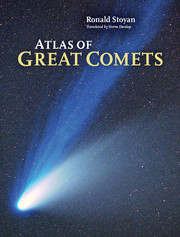Book contents
- Frontmatter
- Dedication
- Foreword
- Contents
- Using this book
- Introduction
- Cometary beliefs and fears
- Comets in art
- Comets in literature and poetry
- Comets in science
- Comet science today
- Great comets in antiquity
- Great comets in the Middle Ages
- Great Comets
- Appendix
- Glossary
- References
- Index
- Figure credits
Great comets in the Middle Ages
from Introduction
Published online by Cambridge University Press: 18 December 2014
- Frontmatter
- Dedication
- Foreword
- Contents
- Using this book
- Introduction
- Cometary beliefs and fears
- Comets in art
- Comets in literature and poetry
- Comets in science
- Comet science today
- Great comets in antiquity
- Great comets in the Middle Ages
- Great Comets
- Appendix
- Glossary
- References
- Index
- Figure credits
Summary
During the Middle Ages, the appearances of Comet Halley marked the passage of time: It was in the sky in the years 530, 607, 684, 760, 837, 912, 989, 1066, 1145, 1222, 1301, 1378 and 1456. Many of its apparitions were very bright and were well-observed in Europe and Asia.
The return in the late summer of 530 was preceded, on 9 April of the same year, by a great meteor shower, when the Earth passed through the orbit. This produced a major outburst of the Eta Aquarid meteor shower, which may be observed every year in April and May. In the Nuremberg Chronicles, the appearance of Comet Halley in 684 was held to be responsible for ‘great rains and lightning strokes’ with injuries and deaths in Italy and Rome. In China the comet was seen for 33 days. Korean and Japanese observations have also been preserved with those from China.
At Easter in 837, Comet Halley made its closest approach to Earth in recorded times. It was less than 5 million kilometres from the Earth. That corresponds to about 13 times the distance to the Moon. At this return the tail was well over 120° long, and the comet's overall magnitude was −4 mag. It was observed from March to May, during which time the tail pointed in every direction in succession on the sky. According to legend, Louis the Pious took the comet as a sign for a return to God, although his chronicler Aginard said to him “Do not fear signs in the heavens, they only frighten fools.” Just one year later, in November and December, another ‘dreadful’ comet appeared, which ‘stretched across the whole sky’.
In 905, a very bright comet appeared in the daytime sky from 18 May. Chroniclers reported ‘a terrible, large, and impressive comet, which terrified everyone that saw it’. In May and June, after perihelion, it was in the evening sky, and its tail reached 100° in length.
- Type
- Chapter
- Information
- Atlas of Great Comets , pp. 45 - 47Publisher: Cambridge University PressPrint publication year: 2015



